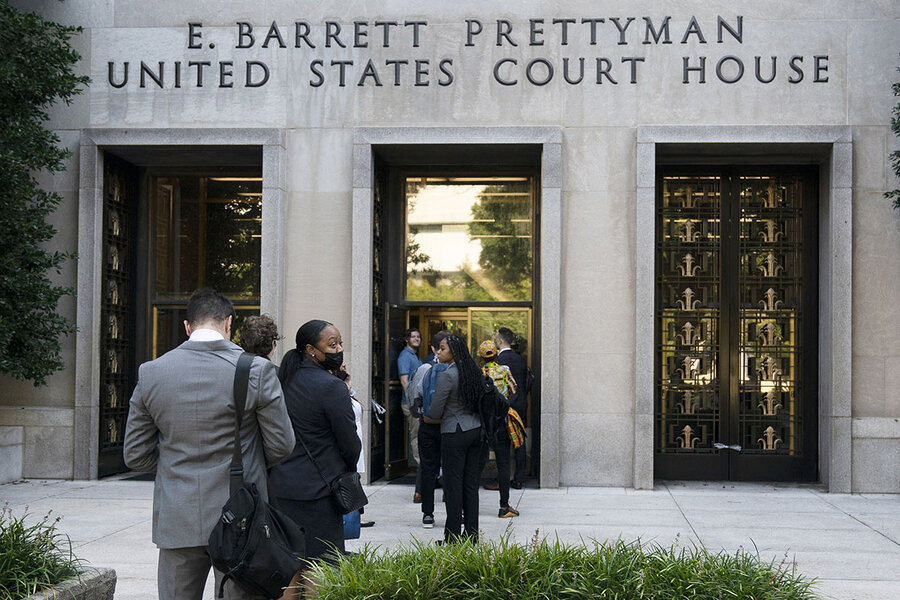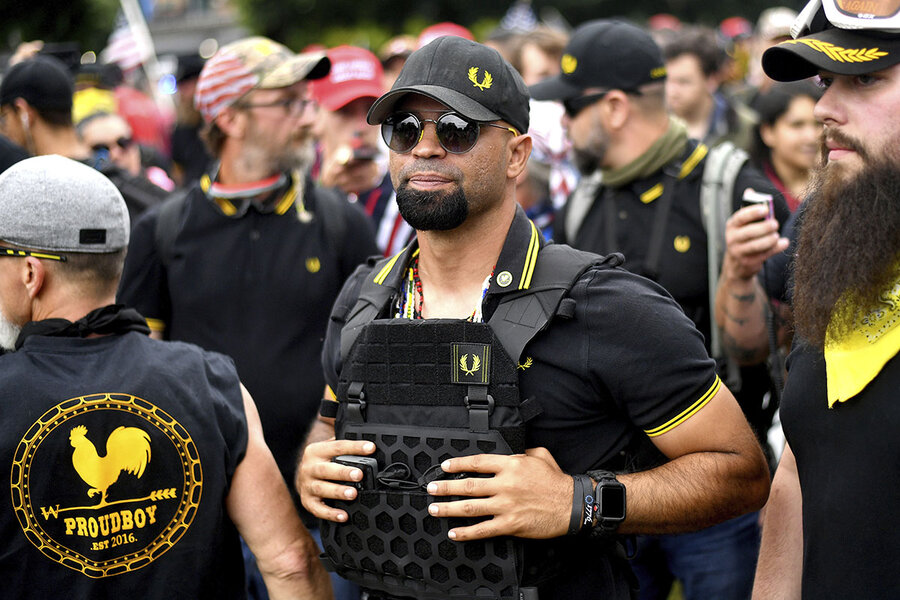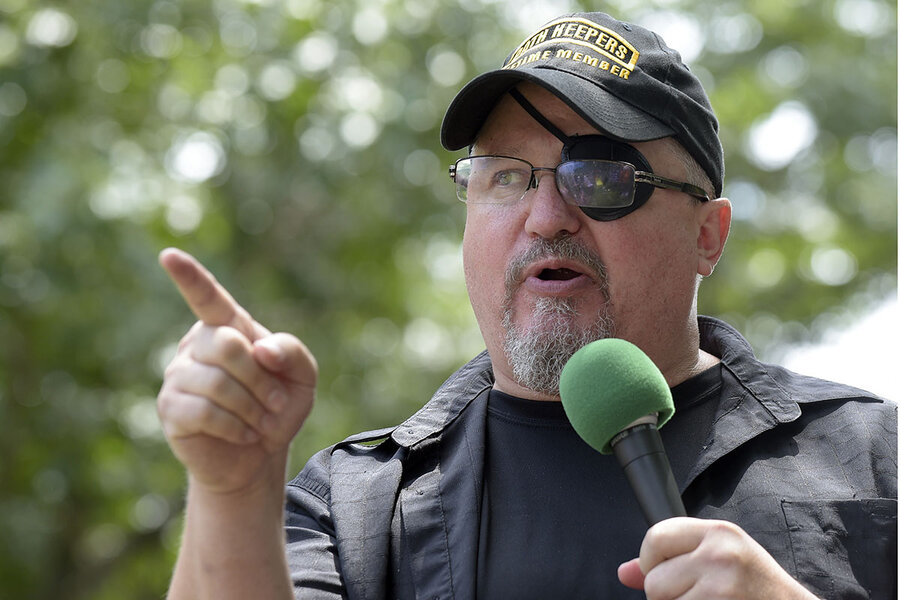Jan. 6 riot prosecutions: Three questions
Loading...
Two years after the Jan. 6 riot at the U.S. Capitol, the Justice Department has shifted its legal pursuit of riot participants to a new, more serious level.
Since it began the investigation of the Capitol insurrection and the prosecution of those involved, the Department of Justice has characterized it as the largest such law enforcement action in the nation’s history. The scale is enormous: Thousands of people were allegedly involved in the melee, ranging from the many demonstrators who merely followed the crowd to a core group that had allegedly prepared for and facilitated illegal entry.
Why We Wrote This
On the second anniversary of the storming of the Capitol, the legal landscape is reaching a new, more intense level. Here’s a snapshot.
But in terms of trying to address the larger problem of extremism in America – the sort of force that drove a crowd of Americans into the Capitol – perhaps law enforcement needs to look down, not up.
Much of the domestic extremist violence in America is driven by individuals who self-radicalize, seizing on conspiracy theories as explanations for their problems, says Jon Lewis of the Program on Extremism at George Washington University.
Addressing that might require a broader approach than prosecuting and dismantling extremist groups.
“The lights on the dash are still red,” says Mr. Lewis. “You’re still seeing these false narratives spread.”
Two years after the Jan. 6 riot at the U.S. Capitol, the Justice Department has shifted its legal pursuit of riot participants to a new, more intensive level.
Federal prosecutors have not yet given any indication of when, or if, they will charge former President Donald Trump and top aides in connection with the attack. Most of the charges brought against the 950 or so defendants, at least the nonviolent ones, have been for minor offenses such as entering a restricted building or illegally demonstrating in the Capitol.
But in November Stewart Rhodes, the leader of the Oath Keepers extremist group, and one of his subordinates were convicted of seditious conspiracy. It was the first time a jury had found that group planning was involved in the disruption of the certification of President Joe Biden’s Electoral College votes.
Why We Wrote This
On the second anniversary of the storming of the Capitol, the legal landscape is reaching a new, more intense level. Here’s a snapshot.
Now the Justice Department is beginning another ambitious, multipart Jan. 6 prosecution, a seditious conspiracy trial against Enrique Tarrio, former Proud Boys national chairman, and four others from the far-right group.
Some Proud Boys played central roles in breaching the Capitol perimeter and the building itself. At the height of the battle one member texted Mr. Tarrio, asking, “Are we a militia yet?”
He answered with one word: “Yes.”
The Proud Boys are one of the key groups accused of preparing to assault the seat of U.S. democracy, says Jon Lewis, research fellow at the Program on Extremism at George Washington University. Their trial – now in jury selection – “is certainly another big test for the Justice Department,” says Mr. Lewis.
Since it began the investigation of the Capitol insurrection and the prosecution of those involved, the Department of Justice has characterized it as the largest such law enforcement action in the nation’s history. The scale is enormous: Thousands of people were allegedly involved in the melee, ranging from the many demonstrators who merely followed the crowd to a core group that had allegedly prepared for and facilitated illegal entry. On the second anniversary of the storming of the Capitol, here’s a snapshot of the legal landscape.
Who’s been charged?
Over the past two years, more than 950 defendants have been arrested in conjunction with Jan. 6, according to a just-released accounting from the U.S. Attorney’s Office of the District of Columbia.
“The Department of Justice’s resolve to hold accountable those who committed crimes on January 6, 2021, has not, and will not, wane,” says the D.C. attorney’s office.
Many of those arrested have faced only minor charges. Approximately 860 defendants have been charged with entering or remaining in a restricted federal building or grounds. But for some, those charges are only a base line. Of those 860 defendants, 91 have also been charged with entering a restricted area with a deadly or dangerous weapon. Some of the longest sentences have been reserved for the 25 people convicted so far of assaulting a police officer, with defendants being sentenced from four to 10 years in prison.
Prosecutors have also moved to hold a number of participants to account for more than simply their presence at the Capitol. More than 295 defendants have been charged with corruptly obstructing or impeding a federal proceeding, according to the Department of Justice. The counting of Electoral College votes was disrupted by the riot. Vice President Mike Pence and congressional members finished it later that night.
Approximately 484 Jan. 6 defendants have chosen to plead guilty. In part this is due to the open-and-shut nature of many of their cases. The Justice Department has amassed a trove of social media posts with pictures, words, and video that place people in the Capitol and show what they were doing at the time.
Forty individuals have been found guilty at trial. Only one has been acquitted. In April, a federal judge decided that Matthew Martin, a government contractor from New Mexico, was not guilty of four petty offenses related to Jan. 6. At trial Mr. Martin admitted that he had entered the Capitol that day, but insisted that two Capitol Police officers waved him through the door.
So far, almost 200 people have been sentenced to periods of imprisonment for their actions on Jan. 6. Thomas Webster, a retired New York police officer and Marine veteran, has received the longest sentence: 10 years for assaulting a police officer and engaging in violence with a dangerous weapon.
Like a significant number of Jan. 6 defendants, Mr. Webster has expressed remorse for his actions. At sentencing he said he had been swept up in politics and should never have traveled to Washington to protest the election.
“I wish the events of that horrible day had never happened,” he told the judge.
Meanwhile, some of the judges overseeing riot-related prosecutions have used their forums to expound in general on the dangers of Jan. 6.
In October, a U.S. district judge sentenced a Texas man who had joined the Capitol mob to 45 days in prison even though prosecutors had not asked for jail time.
It is false to compare the Capitol rioters to the people who have demonstrated, mostly peacefully, for civil rights in recent years, said Judge Tanya Chutkan.
Doing so “ignores the very real danger that the Jan. 6 riots pose to the foundation of democracy,” she said.
Who’s been convicted?
The biggest Jan. 6 trial to date has undoubtedly been that of Oath Keeper leader Mr. Rhodes and his subordinates. In November, a jury delivered a mixed verdict, finding Mr. Rhodes and one aide guilty of seditious conspiracy and obstruction of an official proceeding, among other charges, though not guilty of two separate sedition charges. Three other Oath Keepers were found not guilty of sedition, but guilty of other felonies. Mr. Rhodes faces up to 20 years in federal prison on the seditious conspiracy charge alone.
The verdict appeared to reflect the jury’s judgment of culpability in the situation, said some legal experts, with leaders held most accountable. Though not a complete victory for the Justice Department, the verdict ratified prosecutors’ core contention: Mr. Rhodes and his group had a concrete plan to disrupt congressional proceedings in an attempt to block Mr. Biden from ascending to the presidency.
As part of their case, prosecutors showed the jury hundreds of encrypted text messages between Oath Keeper members discussing means of preventing the transfer of presidential power, and talking about wild conspiracy theories, such as a fear that Mr. Biden would hand control of the United States over to the United Nations.
The Proud Boys trial is the Justice Department’s next step up the prosecution ladder. Prosecutors will argue that five members of the group, including former leader Mr. Tarrio, similarly developed a plan to try to block the Electoral College vote-counting in Congress on Jan. 6.
Mr. Tarrio has depicted his group as more interested in partying than partisan warfare. He was not present in Washington on the day of the riot. He was arrested two days earlier on charges related to vandalizing property belonging to a historic Black church during a previous Washington visit. Ordered out of D.C., he left – but not before meeting with Oath Keeper leader Mr. Rhodes in an underground garage.
What comes next?
The Proud Boys trial in Washington is in its early stages. Jury selection should be wrapped up early next week. If convicted on the seditious conspiracy charge, Mr. Tarrio and his subordinates could face up to 20 years in prison.
For the Justice Department, the “Oath Keepers case was their biggest case to date, a significant win,” says Mr. Lewis of George Washington University’s Program on Extremism.
The Proud Boys prosecution presents similar questions and has similar stakes. It could be another step for the Justice Department in proving that the riot was the result of organized preplanning.
“But I think the bigger question is, what comes next?” Mr. Lewis says.
One answer to that could be more of the same – the Justice Department has vowed to continue its pursuit of individual Jan. 6 participants. Special counsel Jack Smith has the responsibility of weighing whether former President Trump and his top aides and advisers are charged in any way for trying to block the transfer of American power.
But in terms of trying to address the larger problem of extremism in America – the sort of force that drove a crowd of Americans into the Capitol two years ago – perhaps law enforcement needs to look down, not up.
Much of the domestic extremist violence in America is driven by individuals who self-radicalize, seizing on conspiracy theories and social media disinformation as explanations for their problems, says Mr. Lewis.
Addressing that might require a broader approach than prosecuting and dismantling extremist groups.
“The lights on the dash are still red. You’re still seeing these false narratives spread,” says Mr. Lewis.










